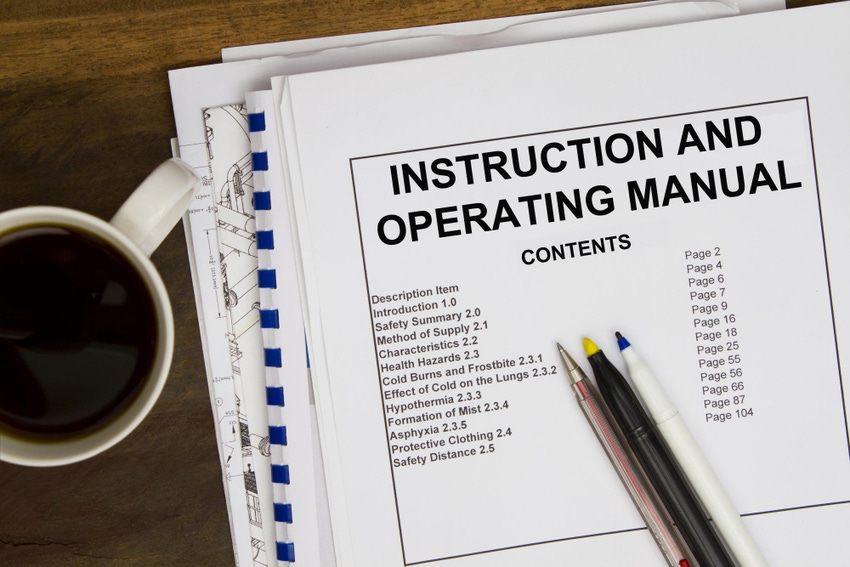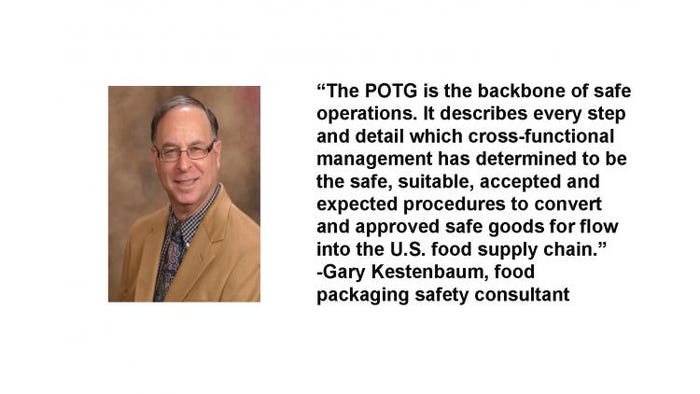December 6, 2016

Expert Gary Kestenbaum advises how a Process, Operations and Troubleshooting Guide can help achieve FSMA Hazard Analysis and Risk-based Preventive Controls compliance.
In August, I described how written specifications represent a cornerstone for food packaging safety and provided guidance on subject matter, detail and content.
Similarly, creating and maintaining a comprehensive Process, Operations and Troubleshooting Guide for each of your products, intermediate or finished, is an integral part of your HARPC, HACCP and food safety programs.
Manufacturers of foods and food contact materials are addressing Food Safety Modernization Act (FSMA) rules with a sense of urgency, as key compliance dates are past or near. As with the other food packaging processes and documents that I recommend, the Process, Operations and Troubleshooting Guide (POTG), an electronic manual intended to instruct, explain, document and troubleshoot, represents evidence of compliance with multiple requirements contained within a variety of FSMA rules.
The POTG is the backbone of safe operations. It describes every step and detail which cross-functional management has determined to be the safe, suitable, accepted and expected procedures to convert and approved safe goods for flow into the U.S. food supply chain. When properly created, vetted and continuously improved, the POTG anticipates and considers every condition, outcome, risk and deviation and in turn provides clear, concise and non-interpretive instructions intended to maintain a safe environment and find, then reject or mitigate non-conforming goods or conditions.
Essentially, the POTG needs to replicate an online recipe and analysis designed for both experts and novices alike, with photos and descriptive language that leaves out nothing and considers everything.
Format for a POTG
POTGs are most functional when they combine table and free text (sentence-based) formats. Avoid unnecessary words and include descriptive, universally-understandable nomenclature. Avoid use of in-house, colloquial terms and descriptions which represent folklore (e.g., “the Bosch”); alternately, use factual descriptions (e.g., “line A, Brand B, Model C form, fill and seal unit”) in order to encourage accuracy among future employees. During the many complex steps included in the manufacturing process, needs are variable. Show steps and processes in table format when possible. Add in detailed written instructions, notes, photos or guidance in sentence form or as “figures” or illustrations. Always include a “risk” column or comment for every step or process which explains the potential harm to food safety and quality if the step is ignored, circumvented or improperly performed.
Typical component sections of a POTG
The following contains sub-sections of a POTG which I consider mandatory. The quality and safety of every food packaging manufacturing or handling process that I have ever been connected with would have benefitted from a POTG that contained these basic subject-related sections. The exact nomenclature may vary based on the exact goods or services, but the concepts are consistent. Document, explain, reference and troubleshoot every aspect. Link all ancillary (“before and after” manufacture) steps and processes to the POTG in order to maintain connections to procurement, intake, quality/safety, discharge and customer receipt.
End product description
Begin with the most basic of components: the packaging material or component description. Describe the item by trade name, generic equivalent and allowable and targeted uses.
Component Bill of Materials
List the bill of materials for all components and ingredients, including processing aids and minority ingredients. Hyperlink each component to its electronic specification file (refer to prior guidance re: comprehensive written specifications) for easy reference.
Process list and overview description
List each process step that the finished item or intermediate product will undergo and create a corresponding descriptive overview. Detailed descriptions of each process and setup will follow. Include an Equipment and Process Description and Flow Diagram.
Process area environmental condition and suitability description
List and describe all area or environmental limits, requirements and conditions which must be satisfied before equipment process and setup begins. Examples include sanitation, decontamination, humidity control etc.
Operator personal protective or required equipment
List and describe required protective or ancillary equipment needed to complete the production process. List the “what”, the “why”, the “how” and the risks if not properly applied.

Equipment changeover, assembly, setup, preparation, inspection and suitability verification
Beginning with the initial process, describe equipment setup and criteria for approval. Explain setups in detail, reference other documents which list details of the setup and explain how to verify successful setup and adjustment completion. Summarize each process using nomenclature that all operators and supervisors understand and use hyperlinks to equipment adjustment manuals. This assumes that the adjustment manuals are accurate, comprehensive and useful.
In-Process test methods description
Include a test and/or analysis evaluation for each step in the process as it is listed. Title it “criteria for success”. Again, use summary language to describe the process and its conclusion and hyperlink test methods for detailed instructions. Add the requisite “risks if not properly completed” section.
In-Process test methods purpose, objectives and overview
Clearly identify the purpose and conditions under which each test is to be performed, the frequency, number of samples and location where samples are to be acquired.
Testing protocol setup, calibration, expected results and disposition or actions
If applicable, describe setup and calibration of in-process or post-process test equipment for tests that are performed by operators and helpers. Generally describe the test process, possible results (in-specification, marginal and out-of-spec) and reference visual or sensory aids, examples and standard references.
Troubleshooting guides for all processes
Anticipate everything that can go wrong with every process, machine or step. Describe each non-conformance or sub-standard condition or result and describe corresponding corrective or affirmative actions which may return the system to steady state or the production quality and safety back into acceptability. Explain the non-standard condition, potential causes, risks to quality/safety and methods for adjustment, correction and post-adjustment evaluations.
A glossary of terms, forms and expected performances
Add a section or appendix with a “targeted” glossary of terms. Include processes, adjustment protocols, safety and quality procedures, equipment and other items contained within each process. This is especially helpful to junior mechanics, operators and other professionals working “off-shifts” and weekends.
Management and oversight of the POTG
Clearly identify the owner and issuing authority for the POTG. Include a 24 hour phone contact in case of emergency.

Dates of manufacture and batch/lot numbering
Clearly state the formats for dates of manufacture and lot numbers. Provide an example and describe “where DDD = Julian date and YYYY = year of manufacture” or similar.
Packaging BOM
Create a BOM of each of the packaging components (film bags, sleeves, hub locks, cases, crates). Create hyperlinks to the specification file as with the product components.
Storage and shipping descriptions
As with the other sections of the POTG, add specific instructions and descriptions for how and under what conditions the goods are to be packaged, stored and shipped.
Defective and non-conforming goods
In the event that a defect does escape the processes documented in the POG, it is best to create and implement a redundant safety verification process (“plan B”) intended to identify defects which might slip by a primary safety plan. Examples of safety defects include physical defects (metal, plastic, erroneous or missing required alphanumeric text), chemical defects (components, adjuvants or substances unsuitable, excessive or violative in the end product) or microbiological defects (organisms or pathogens known or expected to harm humans, animals or cause the end product to become unusable, unsuitable or violative.
As with specifications, Process, Operations and Troubleshooting Guides are expected to serve two primary functions in the event of safety and quality problems:
They function as a “how to” and “what to” guide for every employee at the facility, at its highest value on “a Sunday night at Midnight”, that is, a skeleton crew with limited maintenance and management support.
They function as evidence to regulatory authorities that written plans, instructions and all related documents and accessories are in place and were created to consider, mitigate or address food safety hazards before they enter the supply chain. If properly written and maintained, the POTG can be seen and used as an integral component and evidence of an effective Food Safety and Hazard Analysis plan (prerequisites and line, hazard or product-specific control points) as defined in FSMA.
Redundant control systems and troubleshooting suggestions represent proof that safety or quality non-conformances were anticipated, considered and mitigated through the use of prerequisite plans, testing, observations, oversight and comparison to expected and in-spec outcomes.
Conclusion
In my experience, a comprehensive and well maintained POTG can be a manufacturer’s savior when dealing with regulatory agencies, customers, the press and the public. Training, corrections, additions, continuous improvements and auditing are critical components of the process. The POTG represents standardization, documentation and explanation.
Gary Kestenbaum has 40 years’ experience in the food and packaging industries, 6 as a supplier with National Starch, 18 as a product developer with General/Kraft Foods and 15 as a packaging engineer and developer with Kraft. As senior food packaging safety consultant with EHA Consulting Group, Kestenbaum provides guidance on packaging safety and suitability-related projects for raw material manufacturers, converters and associated supporting professionals. He can be reached at [email protected] or 410-484-9133. The website is www.ehagroup.com.
About the Author(s)
You May Also Like




